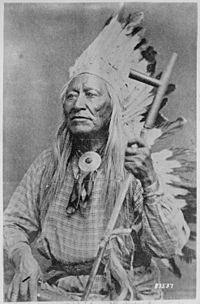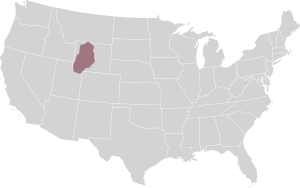Eastern Shoshone facts for kids

Washakie, (translated as:Shoots the Buffalo Running), a respected Eastern Shoshone chief
|
|
| Regions with significant populations | |
|---|---|
| Languages | |
| Shoshone, English | |
| Religion | |
| Native American Church, Sun Dance, traditional tribal religion, Christianity, Ghost Dance |
|
| Related ethnic groups | |
| other Shoshone people, Comanche |
The Eastern Shoshone are a group of Shoshone people. They mostly live in Wyoming and parts of Utah and Idaho. Their traditional lands were in the Rocky Mountains.
These people are part of the Great Basin Indigenous People. They became known for their horse culture, like other Plains tribes. This was different from the Western Shoshone, who kept their Great Basin way of life.
After their leader, Washakie, signed the Fort Bridger Treaty in 1868, many Eastern Shoshone settled. They made their home on the Wind River Indian Reservation in Wyoming.
Contents
The History of the Eastern Shoshone People
Early Life and Horses
The Eastern Shoshone were among the first tribes in their region to get horses. Horses gave them a big advantage. They could travel faster and move more easily during hunts and in conflicts.
With horses, the Eastern Shoshone expanded their territory. They moved into areas that are now southern Alberta, most of Montana, and parts of Wyoming. They often had conflicts with the Blackfoot Confederacy, their neighbors to the north.
Around this time, some of their relatives, the Comanche, moved south. They settled in what is now western Texas.
Changes and New Challenges
Things changed when the Blackfoot tribes also got horses. They also started getting guns from the Hudson's Bay Company through other tribes like the Cree and Assiniboine. This made the balance of power shift.
By 1787, explorer David Thompson noted these changes. He reported that the Blackfoot had taken over much of the Shoshone's land. Sometimes, Shoshone women and children joined Blackfoot families.
Conflicts and Trade
In the early 1800s, the Eastern Shoshone and the Crow tribe often disagreed. They both wanted to use the Wind River Basin for hunting bison. A famous event happened at Crow Heart Butte. There, Washakie, a future Shoshone leader, won a challenge against a Crow warrior. This helped the Shoshone keep control of the Wind River Valley.
The Eastern Shoshone were very involved in the Rocky Mountain Fur Trade from the 1820s to the 1840s. They traded furs and bison hides. Many trading posts were set up in places the Shoshone already used for their own trade gatherings.
Chief Washakie's Leadership
By the 1850s, Washakie became a very important leader. He was known for his skills in battle and his ability to talk with non-Native American settlers. He spoke English well and was friends with Jim Bridger, a famous frontiersman.
Washakie worked hard to create the Wind River Indian Reservation. He did this through important discussions and agreements. These agreements were part of the Fort Bridger Treaty in 1863 and 1868.
Life on the Reservation
After the reservation was established, the Northern Arapaho tribe also came to live on the Wind River Indian Reservation in 1878. Later, some parts of the reservation were changed.
In 1938, the Eastern Shoshone won a legal case called United States vs. Shoshone Tribe of Indians. This case confirmed their rights to use timber and mineral resources on their reservation. It also meant they should receive payment for the Northern Arapaho settling there.
In the 1970s, tribal members found out about an issue with oil production. They discovered that oil field workers were not properly paying for the oil they took from the reservation. This discovery led to important changes and new rules to protect the tribe's resources.
The Shoshone Language
The Eastern Shoshone people speak the Shoshone language. This language is part of the Uto-Aztecan language family. It is still spoken today on the Wind River Indian Reservation.
Eastern Shoshone Bands and Their Names
Shoshone groups, called bands, often got their names from where they lived or what they ate.
- Kuccuntikka (Buffalo Eaters): These were a large group known for having many horses. They lived in areas like the upper Green River Valley and the Wind River region. They were also called Plains Shoshone or later, Wind River Shoshone.
- Haivodika (Dove Eaters): This group lived near white settlements and trading posts, especially around the Green River in Wyoming. They were important traders, helping to exchange goods between different Native American tribes and white traders. When the fur trade ended, many joined other Shoshone groups.
- Tukkutikka (Sheep Eaters): These people lived in the mountains, like the Wind River Range and the Salmon River area. They were also known as Mountain People. Many of them later joined the Northern Shoshone.
- Boho'inee (Sage Grass People): This was a mixed group of Shoshone and Bannock people. They lived in southeastern Idaho, near the Snake River Plain and Fort Hall. They were sometimes called "Sho-Bans."
Modern Eastern Shoshone Communities
Today, Eastern Shoshone people are part of several recognized tribes and communities:
- Northwestern Band of Shoshoni Nation of Utah (Washakie)
- Shoshone Tribe of the Wind River Reservation, Wyoming
- Fort Washakie, Wyoming
- Wind River, Wyoming
- Crowheart, Wyoming
Famous Eastern Shoshone People
Here are some important Eastern Shoshone individuals:
- Cotsiogo (around 1866–1912): A talented artist.
- Washakie (around 1798–1900): A respected war leader and skilled diplomat.
- Eva McAdams (1927–2010): A creator of beautiful traditional regalia.
See also
- Fort Bridger Treaty Council of 1868
- United States v. Shoshone Tribe of Indians (This was an important legal case for the Shoshone Tribe.)


